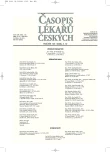Oxidation Stress, Insulin Resistance and Endothelial Dysfunction During the Treatment of Hyperlipidaemia
Authors:
M. Zeman; M. Vecka; P. Stopka 1; M. Zahin; E. Tvrzická; B. Staňková; T. Vařeka; L. Janíková; A. Žák
Authors‘ workplace:
IV. interní klinika 1. LF UK a VFN, Praha
; Ústav anorganické chemie AV ČR, Řež
1
Published in:
Čas. Lék. čes. 2006; 145: 923-928
Category:
Original Article
Overview
Background.
Hyperlipidaemia represents one of the major risk factors of the type 2 diabetes mellitus (DM2). In the pathogenesis of insulin resistance (IR) development glucose homeostasis impairment and their progression into DM2, oxidative stress and endothelial dysfunction (ED) may play an important role. Recent papers indicate the possibility to prevent the development of DM2 by HLP treatment, which is characterised by increased oxidation stress and ED.
Methods and Results.
For the period of twelve months 46 patients with primary HLP (group S) (LDL-C > 4,1 mmol/l a TG <3,5 mmol/l), were treated with atorvastatine 20 mg or simvastatine 40 mg. Patients with LDL-C > 4,1 mmol/l along with TG >3,5 mmol/l were randomly divided into two groups. The SF group was treated with a combination of statin + 200 mg micronized fenofibrate each day, and group SR received together with statin a compound containing n-3 polyene fatty acids (PUFA n-3) in the daily dose of 3.6 g. After one year lasting therapy we found beside the positively influenced concentration of atherogenic lipids and lipoproteins in the group S and SF a significantly reduced concentration of conjugated dienes (CD) in LDL ( -21, resp. 16 %, both P<0,05); the test of KD kinetics in LDL in the group S has marginal increase of the lag phase (P=0.06) and in the groups S and SR also a significant improvement of ED (increase by the flow of mediated vasodilation, FMD) by 20%, resp. by 18% (both P<0,05) and in the SR group a significant decrease of microalbuminuria. We did not proved significant concentrations of insulin, C-peptide or indexes showing the degree of IR (HOMA and QUICKI).
Conclusions.
Long-lasting hypolipidemic treatment positively affected in our study the oxidative stress and ED, however, it did not resulted in changes of IR.
Key words:
hyperlipidemia, statin, fibrate, PUFA n-3, oxidative stress, conjugated dienes, endothelial dysfunction, insulin resistance.
Labels
Addictology Allergology and clinical immunology Angiology Audiology Clinical biochemistry Dermatology & STDs Paediatric gastroenterology Paediatric surgery Paediatric cardiology Paediatric neurology Paediatric ENT Paediatric psychiatry Paediatric rheumatology Diabetology Pharmacy Vascular surgery Pain management Dental HygienistArticle was published in
Journal of Czech Physicians

Most read in this issue
- Hair Whorl-A Genetically Bound Phenomenon in Testing of Right-handedness and Hemispheric Dominance
- Dermatophytoses Transmitted from Animals
- Tako-tsubo Cardiomyopathy – Our Experience and Review of Current Knowledge
- Geriatric View on the Health and Disease in Old Age – Changes in the Paradigm?
